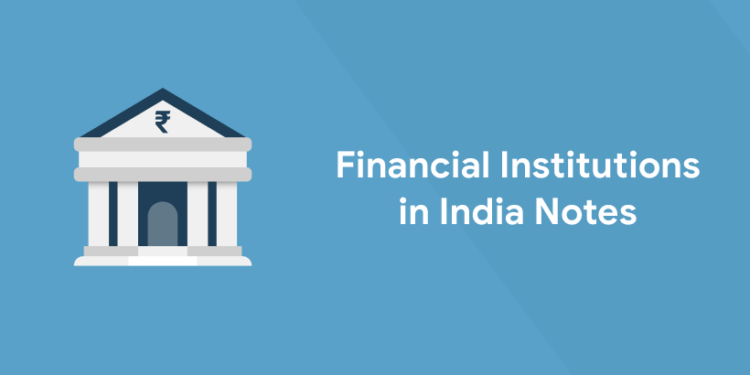Table of Contents
Any individual, let it be virtually or physically will perform a transaction periodically in a developed or developing country or economy. This duly requires the need for the services provided by any financial or banking institution in the country. The Financial Institutions in India or called the Banking Institutions in India are the organisations dealing with collection and distribution of financial and monetary transactions in India. These are the businesses which establish the methods to collect money from one and lend it out to another. This involves deposits, investments, loans and even currency exchange. The regulation of the Financial Institutions of India is under the control of the Banking Regulation Act of 1949. In this article we will be providing you with every detail on Financial Institutions In India.
Prepare for Financial Bank Exams with Entri App!
What do you mean by the Indian financial system ? Any ideas? This is a topic which every individual of the country should be aware of. This topic is not just for people who have applied for a government examination but to every citizen of this country. Candidates applying for a post in the banking field should compulsorily know how the Financial Institutions of India works. So, if you feel like you have zero knowledge about the Financial Institutions of India, then let’s learn this together. The Financial Institutions of India enables both the lenders as well as the borrowers to exchange funds in and out of India. The Indian financial system is controlled by independent institutions in various sectors of finance such as banking, insurance, capital markets and other services. Thus, in the Indian Economy, the Financial Institutions play a vital role in the development of the country.
Components of Financial System in India
There are four major components for the Indian Financial Systems. They are :
- Financial Institutions
- Financial Markets
- Financial Instruments/ Assets/ Securities
- Financial Services
Lets learn in detail about the Public Financial Institutions in India.
Financial Institutions in India
1: What does the acronym "ATM" stand for in banking?
Financial institutions are the basic intermediate contact between the lenders/ investors and borrowers. They facilitate the smooth functioning of the financial system. Financial institutions also lend their advice to the ones in as the part of their service to services to individual, business or the government. These institutions thus act as financial intermediaries because their service makes them a middle man between savers who add funds and borrowers to lend the fund. Financial institutions are categorised as Banking Institutions and Non Banking Institutions.
Banking Institutions
The Indian banking industry is under the control of the Central Bank. The RBI regulates and develops the financial system of India. The Indian banking institutions are classified into two.
- Organised Sector which consists of commercial banks, cooperative banks, regional rural banks and Foreign Banks.
- The Commercial Bank has 27 public sector banks, private sector banks and foreign banks.
- The Cooperative Bank is represented by a group of societies registered under the Acts of the states relating to cooperative societies. They are divided as Rural Credit Societies which are for agriculture and Urban Credit Societies are for non – agriculture.
- Regional Rural Banks were introduced by the government to support cooperative banks in the rural areas. They were introduced to provide credit facilities to weaker sections.
- Foreign Banks are banks that have their branches in different countries with their headquarters in their own country.
- The Unorganised Sector of financial institutions included Indigenous bankers and money lenders.
- Indigenous Bankers are financial middlemen but private owners or firms which operate as banks.
- Money Lenders play with their own funds. They are both professional and unprofessional ones which can be rural or urban based.
Non – Banking Financial Institutions
The non banking institutions are divided into Organised and Unorganised.
- Organised Non Banking Financial Institutions include Development Finance Institutions and Investment Institutions.
- Development Finance Institutions provide medium as well as long term financial services to the corporate and industrial sector. All India level examples are IDBT, ICICI, IFCI, IIBI, IRDC. State level Examples are The State Finance Corporations (SFCs), State Industrial Development Corporations (SIDCs).
- Investment Institutions organise savings via various schemes and invest them in corporate and government securities. These include LIC, GIC, LTT, and mutual funds.
- Unorganised Non Banking Financial Institutions include NBFCs providing financial services. They can be leasing companies, housing finance companies, factoring companies, merchant banking companies etc. NBFCs organise public funds and make it loanable.
Download Financial Institutions in India Notes Here!
Financial Institutions in India – Types
There are five important Financial Institutions in India. They are explained in detail below.
| Financial Institution | Established Year | Chairperson |
| Reserve Bank of India | 1935 | Mr.Shaktikanta Das |
| Securities and Exchange Board of India | 1992 | Mr. Ajay Tyagi |
| Pension Fund Regulatory and Development Authority | 2003 | Mr. Supratim Bandyopadhyay |
| Forward Market Commission | 1952 | Mr. Ramesh Abhishek |
| Insurance Regulatory and Development Authority of India | 1999 | Mr. Subhash Chandra Khuntia |
Reserve Bank of India
The Reserve Bank of India (RBI) manages the financial system of the country owned by the Government of India after independence. It is called the central bank of India, established in the year 1935 under the Reserve Bank of India Act, 1934.the bank supports the Indian government in the various development projects and schemes. The board consists of a Governor, Deputy Governors and members recruited by the government. Mr.Shaktikanta Das is the Governor of the Reserve Bank of India. The Reserve bank head office was situated in Kolkata when it was earlier established. Right now the RBI head office is situated in Mumbai.
The functions of the RBI are as follows :
- The bank regulates supply of the Indian rupee.
- It also looks after the central government’s money.
- RBI is the Issuer of notes. It prints currency notes except 1 rupee note.
- RBI controls all the banking functions of the central and state government of the country.
- Adviser of the government on monetary policy.
- It is the Banker’s bank.
- Regulator of the financial system of the country. It controls inflation in the economy.
Securities and Exchange Board of India
SEBI is the body established on April 12, 1998 to develop and regulate the stock market in India. Through Securities and Exchange Board of India Act 1992, the board acquired statutory powers. The primary objective of the SEBI according to the preamble of the SEBI Act, is to promote healthy and orderly growth of the securities market and secure investor protection. Thus the SEBI monitors the activities of stock exchanges and merchant bankers.
The functions of SEBI are given below.
- To ensure a steady flow of savings into the capital market.
- To ensure that there are effective services available by brokers and merchant bankers so that they tend to be competitive in nature.
- Section 11 of the SEBI Act specifies the regulatory and developmental function of SEBI.
- Regulation of stock exchange and self regulatory organisations.
- To prohibit trading of insiders within securities.
- Regulating the process of acquiring shares and taking over companies.
- SEBI holds the responsibility of imparting knowledge to the investors. Research is done by SEBI for the same which will be useful to participants of the market.
- To make sure Code of conduct for self regulatory organisations are being followed.
Take Free Mock Test on Entri App Today!
Pension Fund Regulatory and Development Authority
In 1999, the Indian Government commissioned a national project “OASIS” or Old Age Social and Income Security. This was commissioned to examine policy related to old age income security in India. Based on this report, the Government introduced the Defined Contribution Pension System for the new individuals entering the Central/State Government service, except for the Armed Forces. Interim Pension Fund Regulatory & Development Authority (PFRDA) was established on 23rd August, 2003. The resolution of the government for the authority was to promote, develop and regulate the pension sector in India. The Pension Fund Regulatory & Development Authority Act was passed on 19th September, 2013 and was notified on 1st February 2014. The role of PFRDA is to monitor and develop the growth of the pension market.
The Preamble of the Pension Fund Regulatory & Development Authority Act, 2013 describes the basic functions of the PFRDA as –
“…. to promote old age income security by establishing, developing and regulating pension funds, to protect the interests of subscribers to schemes of pension funds and for matters connected therewith or incidental thereto.” The Head Office of the Pension Fund Regulatory and Development Authority is situated in New Delhi and consists of a Chairperson and six members who are appointed by the central government. Shri Supratim Bandyopadhyay is the current chairperson of the PFRDA.
Forward Market Commission
Like all other financial institutions regulates one or the other services of the nation, the Forward Markets Commission (FMC) regulates the commodity market. So FMC can be called as the nation’s commodity regulator. The FMC headquarter is located in Mumbai and it comes under the Ministry of Consumer Affairs, Food and Public Distribution. FMC was established by the Forward Contracts (Regulation) Act 1952. According to the Act, the commission comprises minimum 2 or maximum four members, all appointed by the central government.
Functions of FMC are listed below.
- To observe forward markets and to take action related to them.
- To collect commodities and datas whenever the Commission thinks it necessary
- Publishing the required information regarding trading of respective goods to which any of the provisions of the Act is made applicable.
- To submit periodical reports on the working of forward markets.
- To propose measures to improve the FMC and working of forward markets.
- To undertake the inspection of accounts and other documents of any recognised association, registered association or any member of such association whenever it considers it necessary.
At present, there are a total of 5 national exchanges. They are :
- Multi Commodity Exchange
- National Commodity and Derivatives Exchange
- National Multi Commodity Exchange
- Indian Commodity Exchange Ltd
- ACE Derivatives and Commodity Exchange
Besides the 5 mentioned above, there are 16 more commodity specific exchanges recognised for regulating trade in various commodities approved by FMC under the Forward Contracts (Regulation) Act, 1952. Commodities traded under these exchanges are listed below.
- Edible oilseeds: Groundnut, mustard seed, cotton seed, sunflower, rice bran oil, soy oil, etc.
- Food grains: Wheat, gram, dals, bajra, maize etc.
- Metals: Gold, silver, copper, zinc etc.
- Spices: Turmeric, pepper, jeera etc.
- Fibres: Cotton, jute, etc.
- Others: Gur, rubber, natural gas, crude oil etc.
Insurance Regulatory and Development Authority of India
IRDAI stands for the Insurance Regulatory and Development Authority of India. IRDAI controls all the insurance businesses in the country and they supervise the functioning of Life Insurance and General Insurance companies. The Insurance Regulatory and Development Authority of India (IRDAI) is an autonomous regulatory body. They monitor and regulate the insurance sector in India. The IRDAI was established by the IRDAI Act in 1999. Function of IRDAI as per their mission statement are listed below.
- To protect the interest of and secure fair treatment to policyholders
- To bring about speedy and orderly growth of the insurance industry for the benefit of the common man
- To provide long term funds for accelerating growth of the economy.
- To set, promote, monitor and enforce high standards of integrity, financial soundness, fair dealing and competence of those it regulates.
- To ensure speedy settlement of genuine claims, to prevent insurance frauds and other malpractices and put in place effective grievance redressal machinery.
- To promote fairness, transparency and orderly conduct in financial markets dealing with insurance
- To bring about optimum amount of self-regulation in day-to-day working of the industry consistent with the requirements of prudential regulation.
Financial Institutions in India – Role
- Provide various financial services to the customers.
- Attractive rate of return is provided to the customers.
- Direct investment is advertised to the customers but also explains the risk associated with that as well.
- Forms liquidity of stock in case of emergency in markets.
Financial Institutions in India – Features
- High rate of return to invested customers.
- Reduction in the cost of financial services provided to the customers.
- Vital for the financial and economic development of the nation
- Studies the customer requirement and guides customers with the equity.
- Uplifts both savings and investment.
- Connects savers and investors and helps in formation of capital.
- Helps in allocation of risks in the financial market.
Take Entri’s Free Mock Test for Banking Examinations!
Hope the article gave a very brief knowledge on the Financial Institutions of India. Any candidate aspiring to achieve a post in the banking sector should be aware of the Financial Institutions in India. This is a topic from which most of the questions arise in all the levels of recruitment process in the banking sector. Widen your knowledge with the Entri Team and grab the best banking opportunities.
Enter the World of Learning with Entri! Download the App Now!











